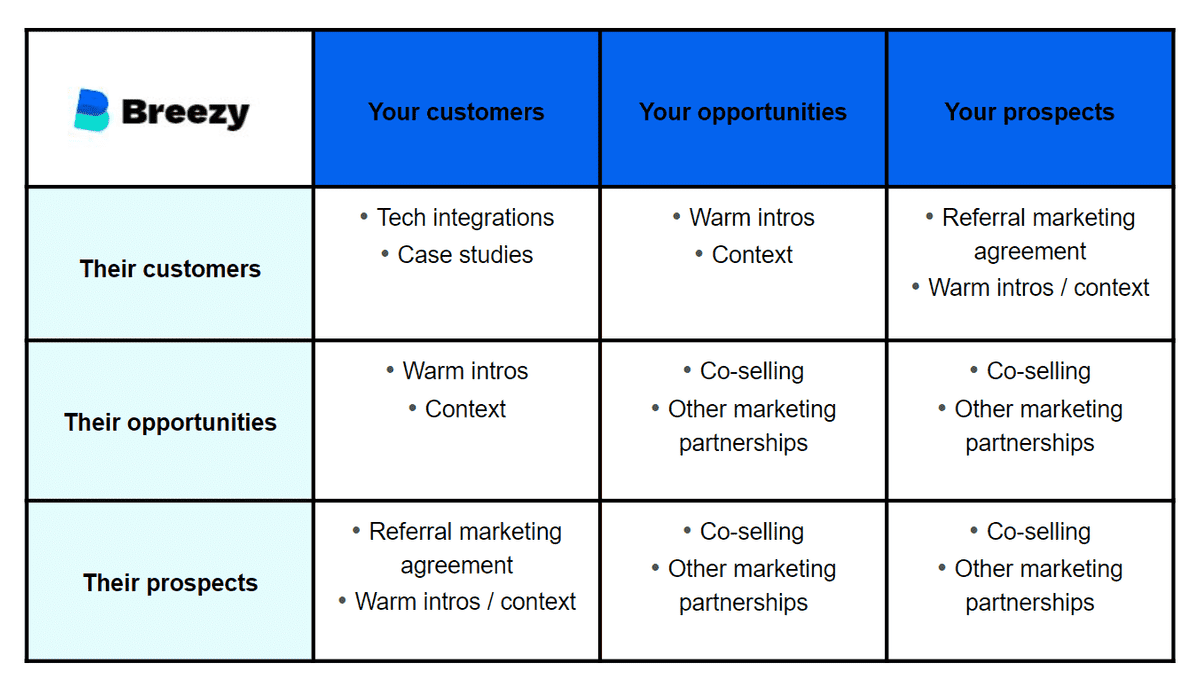A guide to co-selling and how to do it like a pro
- Publication date
- Author
- Imogen Beech
- Reading time
- 13 minute read
You know the phrase ‘two heads are better than one?’ Or ‘teamwork makes the dream work?’
Well, if you’ve ever struggled to sell a product and wished you had someone to help, we’ve got news for you. Co-selling is your friend!
That’s right, co-selling is when your sales team works together with another sales team to get the job done. And it can be a valuable type of B2B partnership for your business.
In fact, when we say valuable, we mean really valuable. Crossbeam has shown that deals are a whopping 53% more likely to close when a partner is involved – and 46% faster!
Here, we’ll help you to become a pro at co-selling, so you can reap its many benefits. But first…
Co-selling, also known as solution selling, is when sales reps or teams from two or more businesses team up to better sell solutions.
The idea is that, by combining their skills and expertise, partner brands can sell more effectively to their joint customers.
In a co-selling partnership, partner brands need to be highly in sync with one another. They must hone their go-to-market strategy and messaging throughout the sales process, in order to complement one another’s efforts rather than undermine them.
One of the most famous examples of successful co-selling is Microsoft, which has a full co-selling program. Through it, the multinational technology corporation partners with thousands of brands that work with Microsoft employees to sell services that have been built on or that support Microsoft technology – or with other partners that are also part of the program.
By the end of the program’s first two years alone, Microsoft had already made $8 billion in partner revenue (according to CRN). Fast-forward a little, and 95% of the corporation’s commercial revenue now comes from partners (according to Microsoft itself).
There are two main types of co-selling partnerships.
Co-selling partnerships are particularly common in the tech industry. Usually, these partnerships involve sales reps from partner companies teaming up to sell their individual products to the same customer at the same time.
In order for this kind of co-selling partnership to work, the partner brands should sell products that complement one another. This will enable them to offer a more attractive, holistic solution to their end customer.
Many tech companies that choose to co-sell in this way also embark on product integrations – this is a kind of product partnership that involves SaaS businesses connecting their products in order to create a more seamless experience for their joint customers. Collaborating to both integrate and co-sell their technologies allows brands to combine their efforts in order to more successfully sell a new, joint solution to a shared target market.
Similarly, co-selling among tech companies often shares a large overlap with bundling – the act of partner brands combining their products into a single offering. That said, while bundling and co-selling often go hand in hand, there is a key difference. Co-selling specifically refers to the process of brands working together to sell their solution, helping to improve conversion rates for them both.

Co-selling is also fairly common between brands from different parts of a supply chain.
Instead of working together to jointly sell two individual products, in a channel partnership, brands from different parts of a supply chain – often the vendor and a reseller – pool their knowledge and expertise to better pitch a single product to the end customer.
The idea here is that the vendor knows the product best, but the reseller knows the customer best. So, by working together, they’ll be better placed to successfully pitch a solution to customers and will be able to sell more efficiently.
Co-selling in this capacity shares a large overlap with supply chain partnerships. And indeed, you could view it as a type of supply chain partnership, given that these are all about partners from different parts of a supply chain working together to bring benefits to both parties.
However, while supply chain partnerships can take many different forms (from partners working together to make their supply chains greener, to partners pooling their resources to increase their supply chain’s efficiency), co-selling partnerships are specifically about selling.
Want to know why co-selling is so important for businesses like yours? Well, you just need to look at the stats.
We’ve already mentioned that deals are 53% more likely to close when partners co-sell, and 45% faster. But there’s more!
According to Concur, 77% of businesses operating co-selling programs have seen a direct or indirect profit increase since implementation. As if that wasn’t already appealing enough, almost 9 out of 10 companies surveyed believe that co-selling requires significantly less time and financial commitment than traditional reseller models.
In other words, co-selling brings countless benefits, for just a fraction of the effort and investment.
And it doesn’t end there.
Crossbeam recently revealed some impressive stats to do with the number of sales reps and companies that are embracing ecosystem-led sales through co-selling:
As you can see, co-selling is a fast-growing partnership type. So, if you’re not doing it, the chances are your competitors are (or soon will be!).
Embracing co-selling now will ensure that you remain ahead of the curve and start reaping the benefits of co-selling before your competitors. Luckily, Crossbeam’s data has revealed that although more than 20% of partnership teams have 100% of their sales reps co-selling, approximately 17% of teams have less than 10% of their reps co-selling. The rest of the companies clearly fall somewhere in the middle.
With that in mind, we believe that co-selling hasn’t reached its peak yet, and there’s still time to jump on the bandwagon before it does. There’s no better time than right now!
Co-selling partnerships all involve sales reps or teams working together to sell. But this can look very different depending on the brands, customers and agreement involved.
Essentially, co-selling partners won’t always have an equal contribution, and the level of contribution they have might vary widely from deal to deal.
Let’s look at a couple of examples that show just how different this contribution can be…
As you can see, both these examples can be classed as co-selling, as they both involve a partner having some involvement in the sales process. However, while the partner is valuable in both examples, they play a much more important role in closing the deal in the first example than in the second.
With that in mind, it’s important to establish what roles you and your partner expect one another to play in a co-selling partnership. You may also want to discuss how you can credit one another according to the level of contribution that you play in securing a deal, so that the work you’ve put in is reflected fairly in the benefits you receive.
Typically, co-selling all starts with lead account mapping.
Lead account mapping is when partner brands share data about their leads. They usually cross-reference their customers, opportunities and prospects, and look for overlaps. This allows co-selling partners to decide where to concentrate their efforts – although, depending on where the overlaps lie, partners may also decide to embark on other kinds of partnerships (such as tech integrations, content marketing partnerships and co-branding) to make the most of their mutual leads.

After overlaps have been identified, partners must meet to decide how to make the most of the opportunities they present.
When it comes to co-selling, there are a few different actions that could be implemented. These include:
Of course, the appropriate action will depend on where in the sales funnel leads are and whether they are currently being sold to by one partner or both. With this in mind, a successful co-selling strategy will usually group leads into a number of lists, attaching a different set of actions to each one and prioritising them based on their potential value and likelihood to convert.
Partners that want to maximise opportunities across the whole customer journey will likely collaborate in three key areas while co-selling:
In this way, co-selling isn’t just about working together to close a few key deals. With the right partner, it can be an ongoing collaboration that sees you find and share new leads and opportunities on an ongoing basis, for the benefit of you both.
Co-selling and comarketing often go hand in hand, but they’re not the same thing.
While co-selling is about two (or more) sales reps or teams working together to sell a solution, comarketing is about two brands working together to promote something – whether that’s a product, a piece of content or anything else in between.
That sounds simple enough, right?
Well, it is. But where it can start to get a little confusing is that comarketing can have a place in a wider co-selling strategy. As we touched upon briefly above, co-selling partners might agree to execute comarketing campaigns as a way to recruit new leads and create new opportunities that they can then go on to co-sell to.
In this way, although the two activities are different, you might occasionally see co-marketing listed as a co-selling activity.
The same goes for lead account mapping. Although it’s often seen as part of the process of co-selling, we would argue that it is, in fact, its own type of strategic partnership. While lead account mapping is a crucial step in showing you where to focus your co-selling efforts, the overlaps can also spur partners on to embark on other kinds of strategic partnerships – in other words, while lead account mapping is a vital part of co-selling, co-selling won’t always be a part of lead account mapping.

Depending on the level of input your co-selling partner has – and the kinds of co-selling activities you agree to embark upon – co-selling can come with a whole host of strategic partnership benefits. These include:
Ready to reap the benefits of co-selling? Just follow these six simple steps to get started.
First things first, you’ll need to identify suitable co-selling partners. This is all about finding the right fit – look for brands that:
Don’t forget to use Breezy to uncover hundreds of relevant partner prospects that match your criteria. Just book a demo to get started.
Next, it’s time to start your outreach to potential partners that you think could be suitable.
When it comes to outreach, your potential partners are probably accustomed to receiving lots of cold emails that they don’t give a second glance to. So, you’ll need to differentiate your brand.
Put yourself in a potential partner’s shoes and present your proposition in a way that focuses on the benefits to them – rather than to you. Make sure to:
With a Breezy subscription, you can request the contact details of brands you’re interested in working with, and we’ll dig out the info for key job roles – that way, you can be sure you’re talking to the right person.
Once you get a response back, you can begin an open dialogue and agree to the next steps together.
Once you’ve agreed to become partners, we’d recommend carrying out lead account mapping.
As a reminder, lead account mapping is when you cross-reference your list of customers, opportunities and prospects with your partner’s, looking for overlaps.
This can often be where co-selling partnerships run into difficulties, as neither partner wants to be the one handing over their list of leads for the other brand to cross-reference against their own. But at the same time, the brand doing the cross-referencing can end up spending hours manually going through every lead, which is inefficient, time-consuming and inaccurate.
Using an online tool like Crossbeam can prevent these kinds of issues and inequalities. Both brands input their data and the platform finds the overlaps for you.

Now that you know where your overlaps are, it’s time to make a plan for how to make the most of them.
Often, partners will choose to share more data with one another about mutual leads. Once this information has been exchanged and all your cards are on the table, you can work together to decide how you can use the information to benefit you both.
As part of a joint plan, you’ll want to decide which groups of leads to prioritise. For instance, you might decide to target leads that you’ve both identified as opportunities. Or, you might decide to focus on leads that one brand has identified as opportunities and the other brand has identified as customers.
Your strategy will depend on what group you’ve decided to focus on. For instance, if your priority is leads that are already customers for one brand but opportunities for the other, your strategy will likely focus on providing warm intros for one another.
Regardless, make sure that your planning includes:
It’s best to lay this all out in writing in a way not dissimilar to a partner marketing plan. That way, you’ll both be on the same page and can be held accountable if action points aren’t upheld.
Once you have a solid plan in place that you’ve both agreed to, it’s time to put it into action!
The great thing about writing everything down in a plan is that it will tell you exactly what to do. This should limit things going wrong, or disagreements from occurring. Where something hasn’t been actioned, you can simply refer back to the written plan to see whose responsibility the action was and, hopefully, get things back on track.
However, it’s important to note that even if your actions are separate from your partner’s, you’ll still need to check in regularly with one another.
Make sure to schedule regular meetings, rather than just catching up when something goes wrong. This way, you can catch any small niggles before they turn into bigger problems that are harder to solve.
It’ll also allow you to build a personal relationship. This is key to getting your partner team (and yours!) more invested in the collaboration, and to make sure everyone feels seen and heard.
Finally, it’s really important to measure your co-selling activities – that way, you can understand whether or not you’re achieving your goals.
Remember those KPIs that you (hopefully!) put in place when you created your joint plan? Make sure that everyone knows who is responsible for measuring what, and ensure that the results are shared between you.
It’s vitally important that you and your partner are both reaching your goals, so you should be just as invested in your partner’s KPIs as you are in yours. If you’re benefitting from the collaboration but your partner isn’t, it’s only a matter of time before things break down – in fact, this is one of the top reasons why partnerships fail!
Where there’s room for improvement, you should collaborate to hone your co-selling activities and tactics.
Equally, if you’ve been working through a specific segment of mutual leads, you might find that you eventually run out. If this is the case, you’ll likely need to take another look at the overlaps that were identified during lead account mapping and pick another segment to focus on. This will involve revisiting your joint plan and amending your strategy accordingly.
–
As you can see, co-selling takes a bit of work. But it’s absolutely worth it to be able to increase your close rate, close deals quicker, boost your revenue and get warm introductions to heaps of new leads.
Not only that, but as more and more businesses are turning to co-selling or ramping up their existing co-selling activities, now is the ideal time to get started. If you don’t do it, your competitors surely will.
Ready to get started? Then don’t forget to book a demo for Breezy. We can’t wait to show you how our partner intelligence and discovery platform can be used to give you tons of relevant co-selling partner suggestions.
Imogen is a copywriter and content writer with over two years’ experience writing about the exciting world of strategic partnerships, as well as running her own business. She loves learning about new topics as she writes, and has enjoyed penning articles on industries ranging from mortgages to events, theatre to home improvements and everything in between.
View more by Imogen Beech